Definition
A maximal coupling between two distributions \(p\) and \(q\) on a space \(X\) is a distribution of a pair of random variables \((X, Y)\) that maximizes \(P(X = Y)\), subject to the marginal constraints \(X \sim p\) and \(Y \sim q\).
A few things about this definition we should pick out before going forwards:
- This is a statement about making a joint distribution given two marginal distributions. For a great introduction to how to manipulate correlations while specifying marginal distributions, see Thomas Wiecki's nice post on copulas here.
- The definition makes no claim that a maximal coupling is unique, and in fact, it is not.
- This maximizes \(P(X=Y)\), so if we are thinking about applications, we had better make sure that \(X = Y\) even makes sense: \(p\) and \(q\) should be distributions over the same stuff.
Sampling from a maximal coupling
It helps the intuition to see a few examples of maximal couplings. Each figure includes the average "cost" of sampling from the joint distribution, as described in the paper.One unit of "cost" is a draw from either distribution, and a (log) probability evaluation from both distributions. So one draw, two evaluations.
Using this Python library, these distributions are generated using code like
import scipy.stats as st from couplings import maximal_coupling q = st.norm(0, 1) p = st.norm(1, 1) points, cost = maximal_coupling(p, q, size=5_000)
See below for details of what maximal_coupling is actually doing.
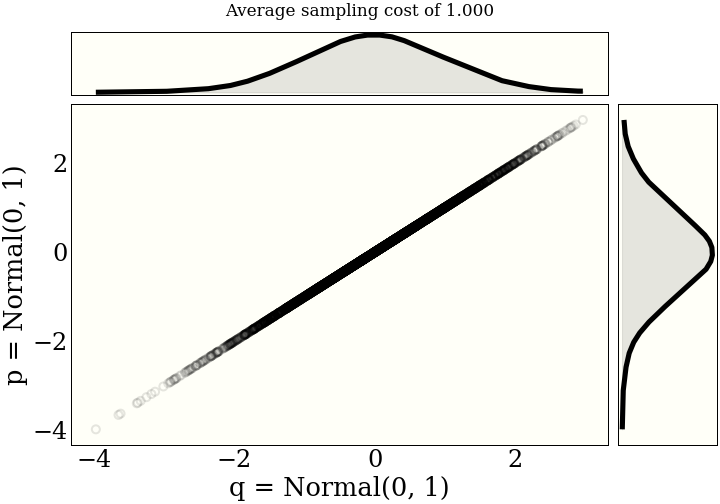
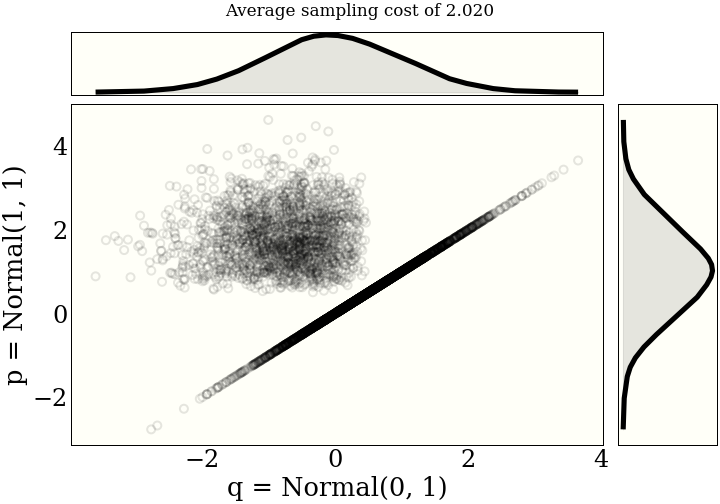

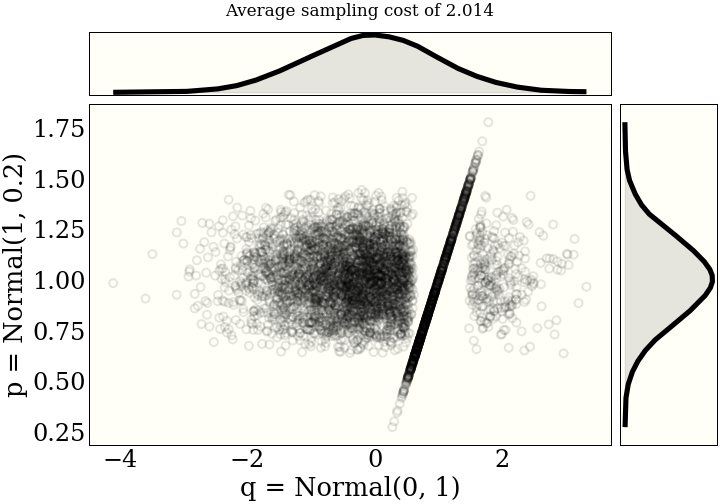
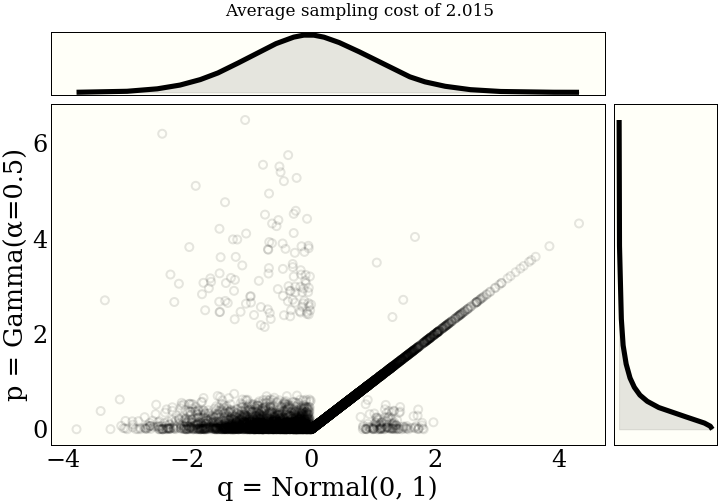
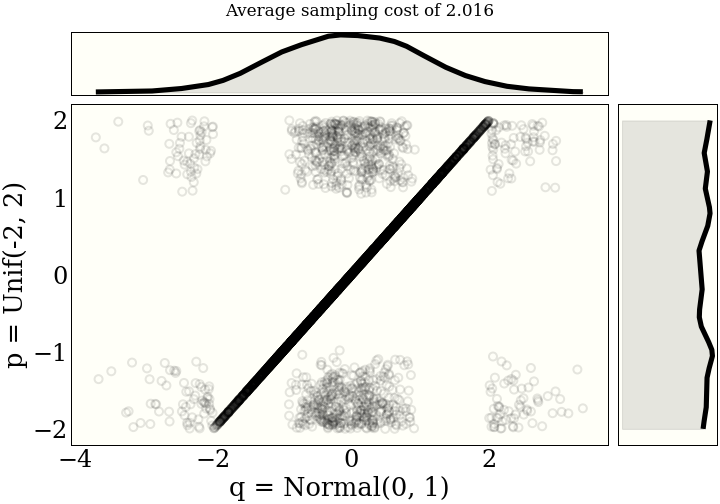
How does it work?
Here is a pseudocode implementation that happens to work in Python, and corresponds to algorithm 2 in Unbiased Markov Chain Monte Carlo with Couplings.
In the actual library note that this is all vectorized, and the
code is optimized a bit more. We also keep track of the cost of running the algorithm: the first
return takes one sample and two pdf evaluations, which is one "cost" unit. The while
loop also takes one "cost" each time through.
def maximal_coupling(p, q):
X = p.sample()
W = rand() * p(X)
if W < q(X):
return X, X
else:
while True:
Y = q.sample()
W = rand() * q(Y)
if W > p(Y):
return X, Y
Also, you can see why we might expect that \(X = Y\) at least some of the time due to the first
if statement above, though that is certainly not a proof that this algorithm is correct.
The interested/motivated reader can find a proof that this creates a maximal coupling by looking at the
reference above.
Other maximal couplings
In the above algorithm, conditional on \(X \ne Y\), \(X\) and \(Y\) are independent. For reasons that are helpful later, we might instead use a maximal coupling that correlates \(X\) and \(Y\). It turns out to be particularly useful in the context of Metropolis-Hastings, to specialize this algorithm to the special case where \(p\) and \(q\) are given by $$ \begin{eqnarray} p &=& \mathcal{N}(\mu_1, \Sigma) \\ q &=& \mathcal{N}(\mu_2, \Sigma) \\ \end{eqnarray} $$ Specifically, in this case, \(\Sigma\) is the covariance matrix for the proposal distribution, and \(\mu_j\) is the current position of the two "coupled" chains. It is not important to understand that yet.
This is called a reflection maximal couplingThis is also implemented in the coupling
library, in a very efficient (vectorized) manner. The implementation is pretty tricky, but well
tested and fast, since it forms the backbone for much of the unbiased MCMC part of the
library., and looks even more ridiculous. Note that the distributions need to be
(multivariate) normals, and the covariances (standard deviations) have to be the same, so we are just
changing the means.


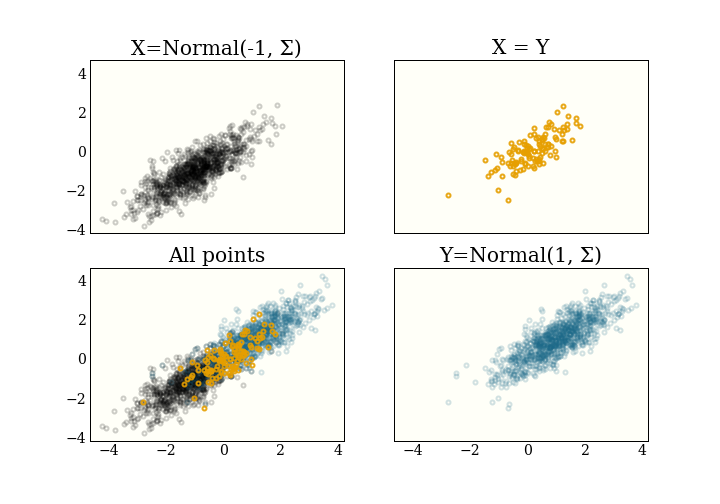
Conclusion
In itself, we might just view this as a statistical curiosity, and use it to think about how flexible a joint distribution can be, even after fixing the marginal distributions. In followup posts, I will write more about how maximal couplings are used for unbiased MCMC.